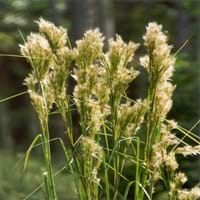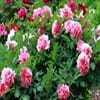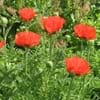Life Span
Perennial
Perennial
Type
Flowering Plants, Herbaceous Perennial
Grass
Origin
Asia
Caribbean, Central America
Types
Bowl of Beauty, Laura Dessert
Broomsedge Bluestem, Broomsedge
Number of Varieties
Not Available
Habitat
Dappled Shade, Woodland Garden
ditches, Grassland, Moist Ditches, Moist Soils, Roadsides
USDA Hardiness Zone
4-8
5-9
Sunset Zone
A3, 1a, 1b, 2a, 2b, 3a, 3b, 4, 5, 6, 7, 8, 9, 10, 11, 12, 13, 14, 15, 16, 17, 18, 19, 20, 22
H1, 3a, 3b, 4, 5, 6, 7, 8, 9, 14, 15, 16, 17, 18, 19, 20, 21, 22, 23, 24
Habit
Clump-Forming
Upright/Erect
Flower Color
White, Light Pink
Cream, Green, White
Flower Color Modifier
Bicolor
Bicolor
Fruit Color
Not Available
Not Available
Leaf Color in Spring
Red, Dark Green, Bronze
Green, Blue Green
Leaf Color in Summer
Green, Dark Green
Light Green
Leaf Color in Fall
Green, Dark Green, Bronze
Gray Green, Yellow green, Bronze
Leaf Color in Winter
Not Available
Gold, Tan, Bronze
Leaf Shape
Lance shaped
Grass like
Plant Season
Spring, Summer
Fall, Winter
Sunlight
Full Sun, Partial Sun
Full Sun, Partial Sun
Type of Soil
Clay, Loam, Sand
Clay, Loam, Sand
The pH of Soil
Acidic, Neutral, Alkaline
Acidic, Neutral, Alkaline
Soil Drainage
Well drained
Average
Bloom Time
Late Spring, Early Summer
Late Summer, Early Fall, Fall, Late Fall, Early Winter
Tolerances
Not Available
Not Available
Where to Plant?
Ground
Ground
How to Plant?
Root Division, Seedlings
Root Division, Seedlings
Plant Maintenance
Medium
Medium
Watering Requirements
Allow soil to be completely dry in between waterings, Water Deeply
Keep ground moist, Water Deeply
In Summer
Lots of watering
Lots of watering
In Spring
Moderate
Moderate
In Winter
Average Water
Average Water
Soil pH
Acidic, Neutral, Alkaline
Acidic, Neutral, Alkaline
Soil Type
Clay, Loam, Sand
Clay, Loam, Sand
Soil Drainage Capacity
Well drained
Average
Sun Exposure
Full Sun, Partial Sun
Full Sun, Partial Sun
Pruning
Remove damaged leaves, Remove dead branches, Remove dead leaves
Cut or pinch the stems, Remove damaged leaves, Remove dead branches, Remove dead leaves
Fertilizers
5-10-10 fertilizer
All-Purpose Liquid Fertilizer
Pests and Diseases
Leaf Blotch, Ringspot virus, Stem rot, Tip blight, Verticillium Wilt
Red blotch
Plant Tolerance
Drought
Drought
Flower Petal Number
Double
Single
Foliage Texture
Coarse
Coarse
Foliage Sheen
Glossy
Matte
Attracts
Ants, Butterflies, Not Available
Birds, Butterflies
Allergy
no allergic reactions
Not Available
Aesthetic Uses
Cut Flowers, Showy Purposes
Ground Cover
Beauty Benefits
Not Available
Not Available
Environmental Uses
Air purification
Air purification, Food for animals, Food for birds, Provides ground cover, Wildlife
Medicinal Uses
Alterative, Analgesic, Anodyne, anti inflammatory, Antibacterial, Antiseptic, Hypotensive, Tonic
Not Available
Part of Plant Used
Root, Seeds, Stem
Seeds
Other Uses
Eaten in a broth, Powdered and mixed with tea
Used as Ornamental plant
Used As Indoor Plant
Yes
No
Used As Outdoor Plant
Yes
Yes
Garden Design
Cutflower, Feature Plant, Foundation, Mixed Border
Container, Dried Flower/Everlasting, Feature Plant, Mixed Border, Rock Garden / Wall
Botanical Name
PAEONIA lactiflora 'Shirley Temple'
ANDROPOGON glomeratus
Common Name
Double Pink Peony, Garden Peony
Bushy Beardgrass, Bushy Bluestem, Bushy Broom Grass
In Hindi
Double Pink Peony
Bushy Bluestem plant
In German
Doppelte rosa Pfingstrosen
Bushy Bluestem Pflanze
In French
Double Rose pivoine
plante buissonnante Bluestem
In Spanish
Doble Pink Peony
planta arbustiva andropogon
In Greek
Διπλό Ροζ Παιωνία
φυτό θαμνώδη BLUESTEM
In Portuguese
Duplo Pink Peony
planta arbustiva Bluestem
In Polish
Podwójne Pink Peony
Krzaczaste Bluestem roślin
In Latin
Geminus Pink AGLAOPHOTIS
Bushy bluestem herba
Phylum
Magnoliophyta
Magnoliophyta
Class
Magnoliopsida
Liliopsida
Order
Dilleniales
Cyperales
Family
Paeoniaceae
Poaceae
Clade
Angiosperms, Core eudicots, Eudicots
Angiosperms, Commelinids, Monocots
Tribe
Not Available
Andropogoneae
Subfamily
Not Available
Panicoideae
Number of Species
Not Available
Season and Care of Double Pink Peony and Bushy Bluestem
Season and care of Double Pink Peony and Bushy Bluestem is important to know. While considering everything about Double Pink Peony and Bushy Bluestem Care, growing season is an essential factor. Double Pink Peony season is Spring and Summer and Bushy Bluestem season is Spring and Summer. The type of soil for Double Pink Peony is Clay, Loam, Sand and for Bushy Bluestem is Clay, Loam, Sand while the PH of soil for Double Pink Peony is Acidic, Neutral, Alkaline and for Bushy Bluestem is Acidic, Neutral, Alkaline.
Double Pink Peony and Bushy Bluestem Physical Information
Double Pink Peony and Bushy Bluestem physical information is very important for comparison. Double Pink Peony height is 90.00 cm and width 90.00 cm whereas Bushy Bluestem height is 120.00 cm and width 75.00 cm. The color specification of Double Pink Peony and Bushy Bluestem are as follows:
Double Pink Peony flower color: White and Light Pink
Double Pink Peony leaf color: Red, Dark Green and Bronze
Bushy Bluestem flower color: Cream, Green and White
- Bushy Bluestem leaf color: Green and Blue Green
Care of Double Pink Peony and Bushy Bluestem
Care of Double Pink Peony and Bushy Bluestem include pruning, fertilizers, watering etc. Double Pink Peony pruning is done Remove damaged leaves, Remove dead branches and Remove dead leaves and Bushy Bluestem pruning is done Cut or pinch the stems, Remove damaged leaves, Remove dead branches and Remove dead leaves. In summer Double Pink Peony needs Lots of watering and in winter, it needs Average Water. Whereas, in summer Bushy Bluestem needs Lots of watering and in winter, it needs Average Water.





